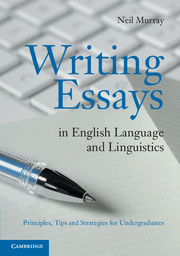 Writing Essays in English Language and Linguistics
Writing Essays in English Language and Linguistics from Part 2 - Getting down to writing
Published online by Cambridge University Press: 05 June 2012
‘It's difficult to know how much I should use my own ideas and how much I should include stuff I've read. And then, I'm not sure how to mention the authors; everyone seems to do it differently.’
The importance of finding your own voice . . . and the need to use sources
In section 1.3 we looked at the idea of ‘voice’ and why it's important to you as a student to develop your own voice; that is, your own way of looking at the world: your own views, opinions or perspectives on issues and your own way of expressing them. Having a view and the courage and conviction to express it, either in writing or orally, is one indication of growing academic and intellectual maturity and self-confidence. However, as we saw in sections 1.6 and 2.4, views cannot be expressed in isolation; they must be grounded in the literature and supported with solid evidence. It is necessary to demonstrate that you are well versed in the relevant language and linguistics debates and the various arguments that compromise them, and that you show how your own views relate to them. In doing so, you contextualise those views and therefore give them greater meaning and significance.
Remember, it's as important to show an awareness of views expressed in the literature that conflict with your own as it is to show awareness of those that agree with them. Part of establishing your own position and making it credible consists in identifying counter-positions and then arguing against them.
This chapter looks at the importance of correctly citing other writers and ways of doing so. We'll start by looking at plagiarism, a word you've probably already heard many times and a label for what is widely regarded as the cardinal sin of academia!
To save this book to your Kindle, first ensure no-reply@cambridge.org is added to your Approved Personal Document E-mail List under your Personal Document Settings on the Manage Your Content and Devices page of your Amazon account. Then enter the ‘name’ part of your Kindle email address below. Find out more about saving to your Kindle.
Note you can select to save to either the @free.kindle.com or @kindle.com variations. ‘@free.kindle.com’ emails are free but can only be saved to your device when it is connected to wi-fi. ‘@kindle.com’ emails can be delivered even when you are not connected to wi-fi, but note that service fees apply.
Find out more about the Kindle Personal Document Service.
To save content items to your account, please confirm that you agree to abide by our usage policies. If this is the first time you use this feature, you will be asked to authorise Cambridge Core to connect with your account. Find out more about saving content to Dropbox.
To save content items to your account, please confirm that you agree to abide by our usage policies. If this is the first time you use this feature, you will be asked to authorise Cambridge Core to connect with your account. Find out more about saving content to Google Drive.